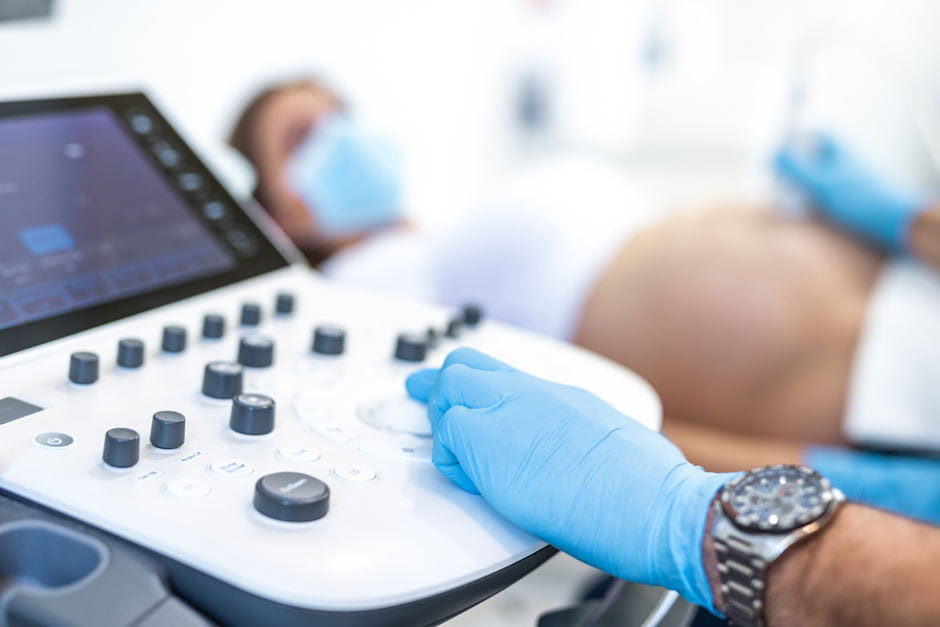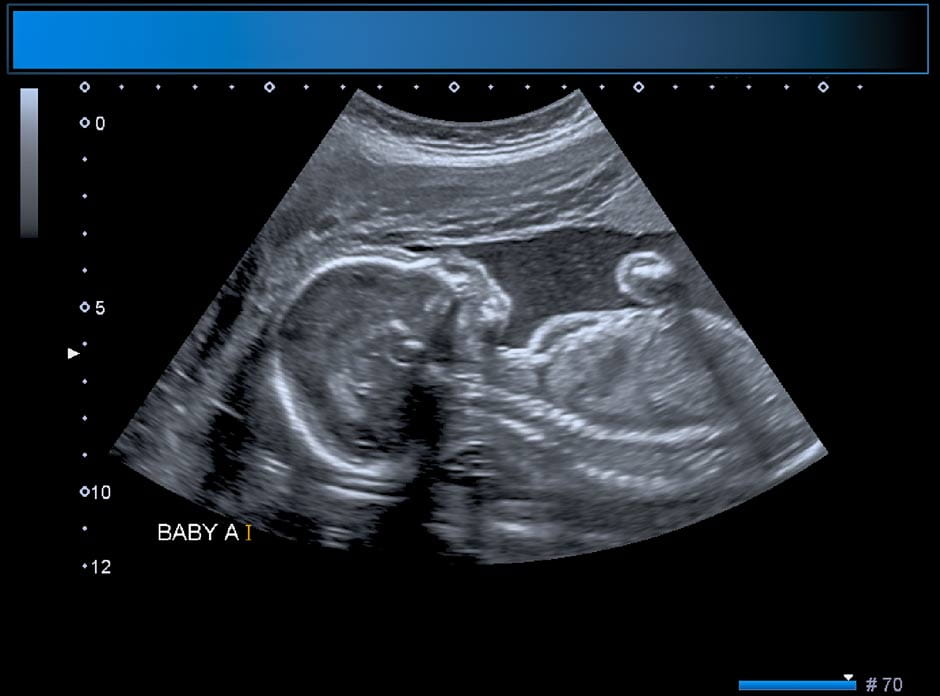 An ultrasound, also called a sonogram, is one of the most commonly used tests during pregnancy. It’s an examination and imaging tool that can give you more details about your pregnancy and the health of your baby.
An ultrasound, also called a sonogram, is one of the most commonly used tests during pregnancy. It’s an examination and imaging tool that can give you more details about your pregnancy and the health of your baby.
During a prenatal ultrasound, sound waves produce images of the baby inside the uterus, allowing you and your provider to see the baby’s organs and how the baby is developing and growing.
Most women will receive at least one ultrasound during their pregnancy. However, if your pregnancy is high-risk, you may undergo more while receiving expert care in our award-winning Maternal Fetal Medicine program.
The vast majority of the 30,000 obstetrical ultrasounds done by our providers at The Ohio State University Wexner Medical Center are the 2D traditional version as that’s the only test that allows us to see the baby’s organs. The 3D and 4D versions, while they can produce cute pictures of your baby inside the womb, are not done routinely and will only be used if needed to help give specific clinical information, such as some facial anomalies.
Why is an ultrasound performed?
Other than giving expectant mothers a chance to glimpse a smile from their growing baby or see a cute “wave” from him or her, ultrasounds have many clinical uses during pregnancy.
Ultrasounds not only measure the size of the baby but also help identify issues and diagnose medical conditions.
An ultrasound might be performed to:
- Determine how many weeks pregnant you are
- Check if you are carrying more than one baby
- Measure size of the baby
- Look for birth defects
- Examine baby’s heart rate
- Screen for risk of a premature delivery
 Types of ultrasound
Types of ultrasound
Generally, ultrasounds are done one of two ways — transvaginally or abdominally.
- Transvaginal ultrasound – Typically done earlier in pregnancy, this type of ultrasound requires a wand, or transducer, to be inserted into the vagina to produce images of the baby, the placenta, or cervix, the opening to the uterus or womb.
- Abdominal ultrasound – When the baby grows a bit bigger, an ultrasound can be done simply by putting a transducer on the belly.
Here are some common ultrasound examinations you might encounter while pregnant:
- Anatomy scan – About halfway through your pregnancy (18-20 weeks), you’ll have a detailed ultrasound that looks at the baby’s organs, size and weight and overall health.
- Cervical length measurement – As part of assessing risk for premature birth, all women who are pregnant will have their cervix measured; this is usually at the same time as the anatomy scan.
- Nuchal translucency – Performed between 11 and 13 weeks, this ultrasound measures the collection of fluid under the baby’s skin at the back of the neck. Blood is taken from mom as well. The combination is a screening test for detecting chromosomal disorders.
- Doppler examination – This technique can be used to evaluate blood flow within the mother’s pelvic vessels and the baby’s blood vessels, including the umbilical cord. It’s only done in some high-risk pregnancies.
- Fetal echocardiogram – A special ultrasound that looks at whether the heart looks normal and works correctly, this test is typically done after 20 weeks for women who have a higher risk of having a child with a congenital heart defect. It’s done in partnership with Nationwide Children’s Hospital.
Risks of an ultrasound
There are no known risks to you or your baby from an ultrasound.
What happens during an ultrasound?
This prenatal test will be performed by one of our physicians or licensed sonographers in a doctor’s office or hospital.
While the process is similar for both, there are some key differences depending on what type of ultrasound you are receiving.
- Transvaginal – During this type of ultrasound, you’ll lie on your back and a wand will be inserted into the vagina while your feet are in stirrups. You might feel some pressure from the wand but not pain. This typically lasts less than 20 minutes.
- Transabdominal – Also performed while you lie on your back, this ultrasound requires the provider to put gel, which helps the sound waves move more easily, on your stomach. Then, the transducer will be moved across your belly creating the images. You may be asked to drink water before the procedure as a full bladder can help produce better pictures.
 Results of an ultrasound
Results of an ultrasound
Results of an ultrasound are often available immediately if a physician is doing the test and sometimes, you’ll even be allowed to view the screen as the test is happening.
If the ultrasound is done by a sonographer, you might have to wait to have it read by a doctor, who will then relay the results to you.
Why choose Ohio State for your ultrasound and prenatal care?
Here at Ohio State Wexner Medical Center, all of our sonographers are certified to ensure the best images of your baby during every ultrasound.
This can give you peace of mind that your pregnancy is progressing properly. However, if a possible problem is identified, our expert Maternal Fetal Medicine team can quickly get you an accurate diagnosis and provide unmatched support and care throughout the rest of your pregnancy.
If your pregnancy is considered high-risk for any reason, here are some of the benefits of being treated at Ohio State Wexner Medical Center:
- We have specialized maternal fetal medicine physicians, nurses and genetic counselors who care for mothers and babies identified as high-risk. We provide prenatal care and delivery planning for all babies identified to have fetal anomalies or pregnancies with red blood cell antibodies that require transfusion.
- Our team collaborates closely with Nationwide Children’s Hospital to ensure the best care and delivery planning for high-risk babies.
- We are have more than a decade of experience performing early fetal echocardiograms.
- Our licensed and board certified team of genetic counselors will review your family history, assess your risks, explain your testing options, help you understand your test results and support you through your pregnancy whenever you have questions or concerns.


 An ultrasound, also called a sonogram, is one of the most commonly used
An ultrasound, also called a sonogram, is one of the most commonly used  Types of ultrasound
Types of ultrasound Results of an ultrasound
Results of an ultrasound


